What am I doing here?
Hazel Karr first contacted JWA because she wanted to add some biographical details to the article in the online Encyclopedia about her grandmother, Esther Kreitman. We struck up a correspondence with her and suggested she write a blog post about the differences between between her mother's artwork and her own.
Hazel Karr comes from a family steeped in art and literature. Her grandmother Esther wrote journal articles, translations, and novels, including the autobiographical Der Sheydim Tants (Deborah) in 1946. Esther’s brothers were Issac Bashevis Singer, winner of the Nobel Prize for Literature in 1978, and Israel Joshua Singer, who wrote extensively in Yiddish. Esther’s son Maurice Carr had a long career in journalism in Paris and Israel; his wife was Hazel’s mother Lola; the daughter of another Yiddish writer (A.M. Fuchs), she painted throughout her life.
In this post, Hazel Karr searches for the meaning in her mother's paintings and in her own.
My mother Lola started painting in the 1950s when I was a little girl. We were living in a tiny hotel room on the Left Bank in Paris. Her very first painting was of the red geranium just in front of the black railing of the window. Both my parents came from literary families. But this was not literature; this was not words in a book. This was color, texture, something we could touch. We were all amazed and bowled over with admiration. A real, live painting!!!
My mother was born in Vienna. In 1938, when she was 23 years old, the Nazis occupied Austria, and she and her family were first put into prison, then expelled from the country. They traveled to Paris and, then to London, where she met my father, Maurice Carr. Then I happened, and we all moved to Paris where my father had been sent as foreign correspondent for Reuters.
Many years later, no longer in the hotel but in a beautiful apartment, I had a cold, had to stay home, and was bored. So my mother gave me one of her canvases and some tubes of paint, and I committed my first painting. It was of a spaghetti-like man sprawled on a table watched in amazement by a blue bird.
Just as my mother had been a dancer, I started life as an actress, but after that first "masterpiece," I went on painting when "resting."
And then I stopped acting and just painted.
Lola painted the story of her life, her life in Vienna, in Paris, in Jerusalem, in Tel Aviv; she painted her parents, her husband, her daughter, the dogs we lived with, the cats. On the surface, they were happy paintings in warm colors, but looking at them now, I see that the bird she painted so often, flying overhead, perched on a balcony, a red or black bird, is menacing, threatening. I think that bird is about Nazism.
And there's the fiacre, the Vienna horse drawn carriage, taking her from Vienna to London, to Paris, to Jerusalem, to Tel Aviv, sometimes all in the same painting. Her theme seems to be exile, journeying into exile. And while that may seem sad, she was a blonde, sunny person, and her paintings glow with joie de vivre.
Unfortunately, I am more like my father, the darker side of the family.
My paintings are also of journeys;, there is often a long straight road with a tiny animal going down it. A rabbit or a dog . . . wandering . . . wondering . . . It walks through a vast, often monochrome landscape . . . Does it know where it's going? Or why ? Probably not, but it goes on, doggedly. Sometimes there are splashes of color, often like explosions, often surrounded by darkness. I like darkness. It seems to me that in the dark there is a glimmer of light, things can be seen, can be dreamt of; one can dive into black. I have a few white paintings done when I was in mourning. I feel white comes back at you like a wall, like a dead-end. I understand why to the Chinese white is the color of death.
Elsewhere on the web:
A chapter of Maurice’s Memoir appears on a website devoted to the fanciful, colorful work produced by Hazel Karr and her mother.
My mother's paintings, it seems to me, are about the past, her lost childhood, her lost city of Vienna. She loved Vienna. They are definitely situated somewhere, even when journeying from city to city.
I think mine are in some unnamed, uncertain place— a sort of void which isn't a void.
Maybe it's a stage—maybe the landscape is a backdrop.
Often there is a tree, sometimes a sun or is it a moon? Just as in Lola's paintings, the bird means danger, a tangible danger; in mine there is also a sense of danger, but it's not tangible. My paintings also have something to do with childhood, not with nostalgia, but with the fears, dreams, and nightmares of childhood. There is also, I think, some Alice in Wonderland-ish humor. But I don't know if this is perceived by anyone but me . . .
Lola uses many colors in the same painting. Her paintings are teeming with life. I have a tendency to use one dominant color, often green or red. Mine are not teeming with life; they are about loneliness in a big empty world. Yet underneath the emptiness, if you scrape away at one of my paintings, you will find a lot of different colors. I start off by splashing paint: yellow, green, red anything that comes to hand on the canvas; then I scratch, then I throw more paint, then I scratch again and so on. Until the painting begins to live it's own life.
I don't really know what I am doing, what I am looking for. I look for some shape and meaning in the chaos I've created, and at the end I feel the need to cover it all with one layer of paint. And then I need to make straight, horizontal lines, as if there was an above and a below.
I think Lola knew what she wanted to paint, what she needed to paint, and she went ahead and painted it. But she was also giving shape and meaning to the chaos of her life.
I think her question was: "How did this happen?"
Mine is: "What am I doing here?"
Sitting here trying to write this, I realize I have more questions than answers. I think I understand my mother's paintings. I'm not sure I understand mine.

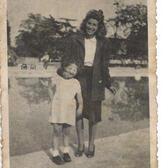
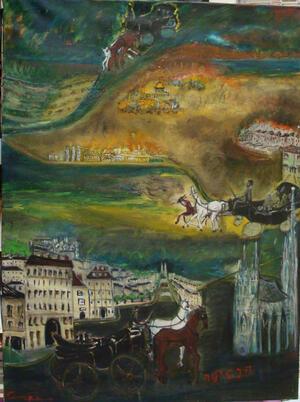
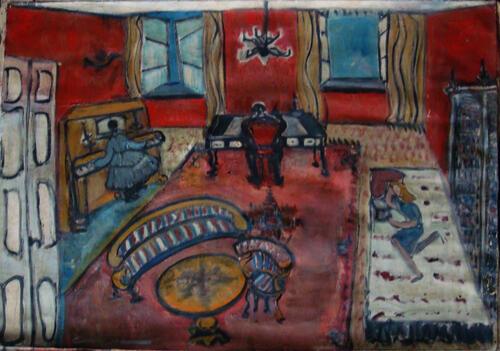
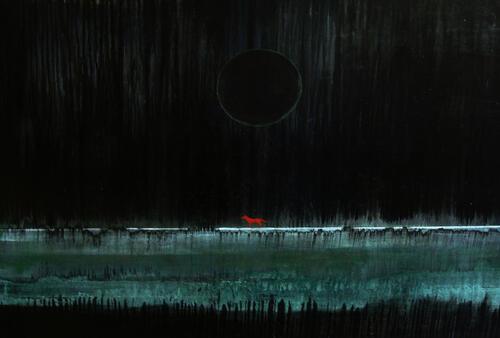
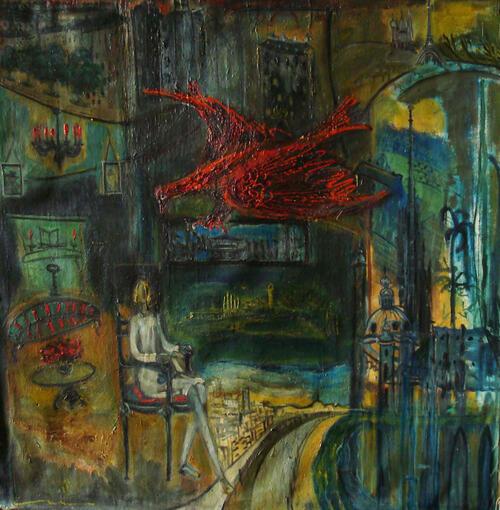





The paintings of Lola and Hazel Carr are, to me, about our unconscious processing of the world--our feelings about the world, others, ourselves. ¡How different they are--how much richer--even if complex and ambigulous--compared to ordinary photographs that reveal so little of our inner lives!
I would like to thank you for putting on line the text by Hazel Karr about her mother's painting and her own painting. Although I have followed Hazel's work for years and have also seen many of her mother's paintings, I found that this imagery in words gives a wonderful insight into both of their works. I can only hope that this notice on your interesting site will draw attention to the paintings of these two very personal artists!! It would be informative if a few more paintings could be included to illustrate the ideas.